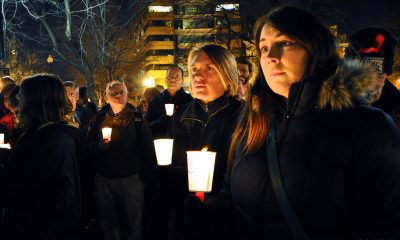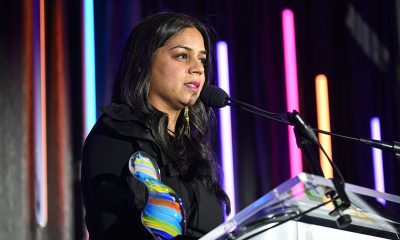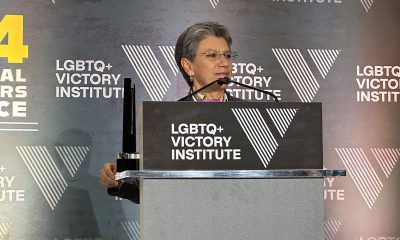a&e features
Liz architect creates a building that fits in and stands out
Annabelle Selldorf honors the past while creating vibrant new spaces
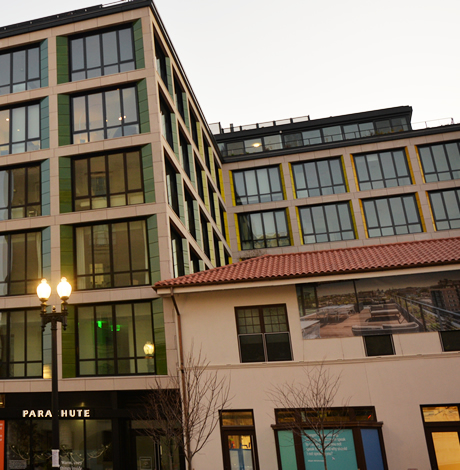

There aren’t many buildings in Washington that are named after a movie star.
Or use an early 20th century garage as modern office space.
Or frame upper-level windows with all the colors of the rainbow
Those are a few of the characteristics of Liz, the mixed-use building on 14th Street N.W. that was named after Elizabeth Taylor and houses the administrative offices of Whitman-Walker Health, a leading health care provider for the region’s LGBTQ community and people with HIV/AIDS. It also has street-level retail space, more offices and 78 apartments.
Creating a building that meets the needs of Whitman-Walker Health and other occupants was the job of Annabelle Selldorf, a prominent New York-based architect who served as the lead designer.
Selldorf, the head of Selldorf Architects, is known for her work with high-profile clients such as the Frick Collection and the Neue Galerie in New York, the Museum of Contemporary Art San Diego and the soon-to-open Rubell Museum in Miami. Liz is her first completed project in the District of Columbia and her first project anywhere for a health care-oriented client.
Her approach was to combine historic preservation and new construction to arrive at a single interconnected structure that both fits in with the surrounding area and stands out as a significant addition to it — a game changer in the cityscape and new front door for Whitman-Walker.
Experienced in blending old and new, Selldorf created a composition in which the new construction is set back or clearly distinguished from the two historic buildings that were preserved as part of the project, so it doesn’t upstage or loom over them.
The goal, she says, was to honor the past while creating new spaces that will enable the city to grow and strengthen Whitman-Walker for the future.
“I’m deeply humbled by having been given the opportunity” to work on the project, she said at the ribbon cutting. “It’s humbling because … this is for people, and if it isn’t for people who are belonging into this place, and if you are not welcoming to everybody, what is the meaning of being an architect?”
Andy Altman, one of the principals of Fivesquares Development, a real estate company that worked with Whitman-Walker, said he and his partners were delighted that Selldorf agreed to take on the project, given her reputation. He said Selldorf is known for work that can be both dignified and playful, that provides a pleasing juxtaposition of old and new, and that’s what his group believed 14th Street and Whitman-Walker needed.
“Annabelle Selldorf is a world-renowned architect who does amazing commissions,” he said at the opening. “We went to Annabelle … and said we want a work that is going to be beautiful, exquisite, bold but subtle, not something ostentatious but that will really be of world-class stature for our city. Annabelle was the choice, and we were thrilled that she would do it.”
Named after Elizabeth Taylor, an actress and early AIDS activist, Liz is a collaboration of Whitman-Walker and Fivesquares, a for-profit, socially conscious developer and contractor that also has its offices in the building.
The completed project, which was dedicated on Nov. 6, occupies an entire city block in the 1700 block of 14th Street, N.W., between R and Riggs streets.
Whitman-Walker, a non-profit with a long history of providing health care for the LGBTQ community and people with HIV/AIDS, owned the block and had used the corner building as the main entrance and waiting area for the Whitman-Walker Elizabeth Taylor Medical Center, which opened in 1993.
When the medical center moved to larger quarters two blocks away several years ago, that freed up space for Whitman-Walker to redevelop its property at 14th and R.
Under its partnership agreement with Fivesquares, Whitman-Walker remained the majority partner in the project, a rarity in collaborations of this kind. Altman says he believes it is “a model of urban regeneration” and “a model for non-profits nationally and what they can do to sustain their mission and serve their needs.”
The initial plan was to build new administrative offices for both Whitman-Walker and Fivesquares, while adding rental housing and street-level commercial space that would generate revenue for the joint venture and add life to the street. As the design evolved, the project gained another component, a cultural center and meeting place that will serve the community at large, especially the LGBTQ community.
Today, the ground floor is occupied by retail tenants and the soon-to-open Whitman-Walker Cultural Center. The second floor is occupied by Whitman-Walker Health, including administrative offices, health and legal services, public benefits and research programs. The third floor is shared by the Goethe-Institut, a German language school, and Fivesquares’ offices. Floors four to seven contain the apartments.
Born in Cologne, Germany, the daughter of architect Herbert Selldorf, Selldorf came to the United States as a young woman to study architecture at Pratt Institute in New York. After working for others, she started her own firm in 1988. She’s part of a small but growing roster of women architects who lead or co-lead design firms in the U.S., along with Jeanne Gang, Elizabeth Diller, Deborah Berke and Billie Tsien.
Selldorf’s firm specializes in designing buildings for art and education, and it has worked internationally on museums, galleries and other cultural projects. Her firm also designed the Sunset Park Materials Recovery Facility on the Brooklyn waterfront, an award-winning garbage recycling center that’s been a popular stop during the annual Open House architectural tours in New York. Critic Paul Goldberger once described her work as “a kind of gentle modernism of utter precision, with perfect proportions.”
Selldorf said in a phone interview that she had no previous connection to Whitman-Walker or Fivesquares but was intrigued when members of the development team approached her about the commission.
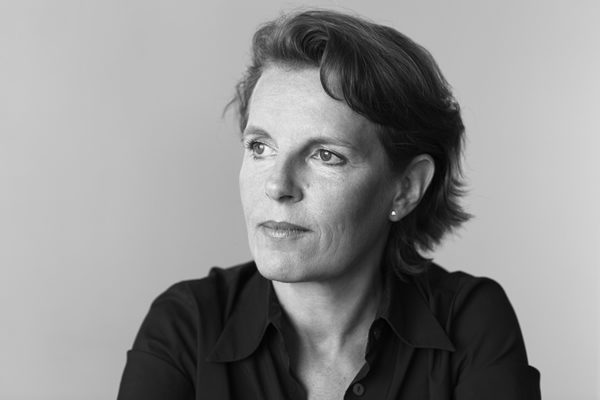
Although she isn’t gay, she said she admires what Whitman-Walker does (and what Fivesquares does) in Washington and could tell they would be the sort of architecturally savvy clients with whom she’s accustomed to working. She was also eager to take on a health care related project, something new for her practice. And although she never met Elizabeth Taylor, she is certainly a fan. “After seeing ‘Cat on a Hot Tin Roof,’” she said,” how could you not be?”
The development team was required by the city’s historic preservation office to save two buildings on the site, the corner structure at 14th and R, which was the front door and waiting room for Whitman-Walker’s Elizabeth Taylor Medical Center from 1993 to 2017 and a flower shop before that, and a midblock building known as the Belmont Garage, significant as an early local 20th century structure with an auto-related use. The team was allowed to demolish a third building on the block that wasn’t deemed historically or architecturally significant
Selldorf said the team sought to maximize the amount of new construction it could build on the site but didn’t want to overwhelm the structures targeted for preservation. Working with CORE architecture + design, the executive architect, Selldorf preserved and renovated the two historic buildings on site and added a 150,000-square-foot structure containing the residences, stores, offices and community space.
“We explored how much space the property would yield,” she said. “We ended with a very happy solution to fully utilize the building envelope and yet come up with something that makes a lot of sense.”
The completed development has what appears to be two new twin structures facing 14th Street, each rising seven stories. They are actually projecting sections of a large building that fills the whole block, containing retail and office space on the lower levels and apartments above.
Along 14th Street, the seven-story sections are separated by the low-rise Belmont Garage, which has been recycled as office space. At the corner of 14th and R, the new construction is set back from the street and frames the historic structure that had been the main entrance to the Elizabeth Taylor Medical Center before it was relocated.
The new construction does not mimic the older buildings on 14th Street. It has clean lines and is free of applied ornament, making it clear what is new and what has been preserved. It’s an optimistic building that is very much about urban rebirth and the co-existence of old and new.
Selldorf hesitates to put any stylistic labels on her design, saying only that she wanted to create a “well-proportioned, contemporary building that takes its cues from the neighborhood in terms of materials and proportioning and has an overall connection” with it
To help the new construction fit in, she said, she specified limestone and terra cotta for the exterior, materials that are common on older buildings in Washington. In an additional nod to Whitman-Walker’s history of serving the LGBTQ community, Selldorf framed the upper-level windows of the new structure with a pop of color.
There are 12 colors in all, and they’re created by a process of glazing the chamfered terra cotta window surrounds with a succession of hues, like a color wheel, working their way around the building. The colors can be seen as a reference to the rainbow flag. They’re also an effective way to animate the facades and indicate that this is a welcoming place for the LGBTQ community.
“It was really a playful gesture,” Selldorf said. “It all has to do with the composition of the facades … I wanted there to be a relationship between the limestone buildings along 14th Street, and then I thought there was an opportunity to have something that wasn’t quite so conservative and old-fashioned.
“I’ve always enjoyed working with terra cotta, so we came up with this color scheme that would go around the windows. It gives the building a kind of lively and friendly and welcoming appearance. The idea is that the colors would graduate into one another and no two colors would not harmonize with one another.”
Another sign of Selldorf’s desire to create a composition that fits in with its surroundings is that she restored the corner building to the appearance it had when it was a flower shop years ago, recreating projecting windows that make it possible to see in and for people inside to see out.
“The corner building was in very bad shape, and so I convinced the client to give us the opportunity to make it as good as it could be and maybe better than it ever had been,” she said.
That transparency represents a symbolic break from the days when many gay people were ‘in the closet’ or shunted out of sight, especially if they were sick. The new windows make the corner building more inviting, while recreating its original look.
These changes are reinforced by a people-friendly design for the outdoor space around the building, by Future Green Studios, that includes generous planting, new seating and public art that encourages people to linger at the corner. The intersection even has graphic ‘bump outs’ on the street surface that appear to narrow the road and increase the amount of space for pedestrians.
“Everything we do is trying to bring people together and create agreeable, open, transparent spaces,” Selldorf said. “It’s not just one specific thing. It’s sort of an idea about how the building represents a kind of openness in the landscape. I think that makes a big difference. It signifies to people that you are welcome there.”
One big decision that grew out of the design process was the idea of recycling the corner building as a cultural center for the LGBTQ community.
Whitman-Walker and Fivesquares didn’t originally plan to have a cultural center as a component of the development. According to Abby Fenton, chief external affairs officer, Whitman-Walker CEO Don Blanchon and others suggested that use as a way to add a new dimension to what Whitman-Walker could do on the block.
The idea is for the cultural center to serve as a flexible meeting and exhibit space that can accommodate a wide range of activities, including talks, readings, art shows and performances of interest to the LGBTQ community.
Seldorf donated her design services for the cultural center component of the project as a way of giving back to the community. Whitman-Walker recently hired a staff curator to coordinate activities and events, and the center is expected to be in full operation by early next year.
“I think they realized how much this corner matters to people in the community and to their specific constituents,” Selldorf said of Whitman-Walker. “This will be an ongoing public service. They became very excited to let their clients have a voice in that way. It’s really a fantastic attitude, and I am very excited to see how it will turn out.”
At the ribbon-cutting, D.C. Mayor Muriel Bowser praised the decision to combine new apartments and medical care with a place for cultural activities.
“Let this project be a reminder that housing, cultural space, and medical care are imperative to how this city moves forward,” she said.
Elsewhere in the project, the designers tried to make it clear which areas of the building are new construction and which parts are old. In some cases, brick walls are left exposed to show that an area is part of a historic building. Other spaces employ colorful lighting and contemporary touches to indicate the space is new. Perkins and Will was the interior designer for Whitman-Walker’s second-floor space.
Whitman-Walker also has an art program in which works by various artists have been put on display to enliven its setting. The organization also displays artifacts salvaged from previous Whitman-Walker locations as a tangible reminder of its history. The largest work of art is an outdoor sculpture on the corner, a temporary installation by Yinka Shonibare.
Above the retail space and offices, on floors four to seven, the apartments include studios and one- and two-bedroom units. Sixty-six are market rate and 12 are considered affordable housing.
On the east side of the block, the building steps back from the alley. The setbacks make it less overwhelming for the smaller townhouse structures across the alley, while creating terraces for the apartment residents on that side of the block.
Yet another sign of Selldorf’s desire to be respectful of Whitman-Walker’s history is that she insists the name of the building is pronounced correctly. She points out that it’s not The Liz building or Liz Taylor Building, but simply Liz.
“I wanted it to be not too institutionalized,” she explained. “If you have to give a building a name, it makes it much more immediate.”
a&e features
Queer highlights of the 2026 Critics Choice Awards: Aunt Gladys, that ‘Heated Rivalry’ shoutout and more
Amy Madigan’s win in the supporting actress category puts her in serious contention to win the Oscar for ‘Weapons’

From Chelsea Handler shouting out Heated Rivalry in her opening monologue to Amy Madigan proving that horror performances can (and should) be taken seriously, the Critics Choice Awards provided plenty of iconic moments for queer movie fans to celebrate on the long road to Oscar night.
Handler kicked off the ceremony by recapping the biggest moments in pop culture last year, from Wicked: For Good to Sinners. She also made room to joke about the surprise hit TV sensation on everyone’s minds: “Shoutout to Heated Rivalry. Everyone loves it! Gay men love it, women love it, straight men who say they aren’t gay but work out at Equinox love it!”
The back-to-back wins for Jacob Elordi in Frankenstein and Amy Madigan in Weapons are notable, given the horror bias that awards voters typically have. Aunt Gladys instantly became a pop culture phenomenon within the LGBTQ+ community when Zach Cregger’s hit horror comedy released in August, but the thought that Madigan could be a serious awards contender for such a fun, out-there performance seemed improbable to most months ago. Now, considering the sheer amount of critics’ attention she’s received over the past month, there’s no denying she’s in the running for the Oscar.
“I really wasn’t expecting all of this because I thought people would like the movie, and I thought people would dig Gladys, but you love Gladys! I mean, it’s crazy,” Madigan said during her acceptance speech. “I get [sent] makeup tutorials and paintings. I even got one weird thing about how she’s a sex icon also, which I didn’t go too deep into that one.”
Over on the TV side, Rhea Seehorn won in the incredibly competitive best actress in a drama series category for her acclaimed performance as Carol in Pluribus, beating out the likes of Emmy winner Britt Lower for Severance, Carrie Coon for The White Lotus, and Bella Ramsey for The Last of Us. Pluribus, which was created by Breaking Bad’s showrunner Vince Gilligan, has been celebrated by audiences for its rich exploration of queer trauma and conversion therapy.
Jean Smart was Hack’s only win of the night, as Hannah Einbinder couldn’t repeat her Emmy victory in the supporting actress in a comedy series category against Janelle James, who nabbed a trophy for Abbott Elementary. Hacks lost the best comedy series award to The Studio, as it did at the Emmys in September. And in the limited series category, Erin Doherty repeated her Emmy success in supporting actress, joining in yet another Adolescence awards sweep.
As Oscar fans speculate on what these Critics Choice wins mean for future ceremonies, we have next week’s Golden Globes ceremony to look forward to on Jan. 11.
a&e features
Looking back at the 10 biggest A&E stories of 2025
‘Wicked,’ Lady Gaga’s new era, ‘Sexy’ Bailey and more

Although 2025 was a year marked by countless attacks on trans rights and political setbacks, the year also saw brilliant queer artists continuing to create art. From Cannes and Sundance Award winners now vying for Oscar consideration to pop icons entering new stages of their careers, queer people persevered to tell their stories through different media.
With the state of the world so uncertain, perhaps there’s no more vital time to celebrate our wins, as seen through some of this year’s top pop culture moments. While there’s no collection of 10 stories that fully encompass “the most important” news, here are some events that got the gays going:
10. ‘Mysterious Gaze of the Flamingo’ wins big at Cannes

The Cannes Film Festival has become a crucial start for films hoping to make their way to the Oscars, and first-time director Diego Céspedes won the top Un Certain Regard prize for his intimate western “The Mysterious Gaze of the Flamingo.” The film is set in the ‘80s and is intended as an allegory for the AIDS epidemic. Seeing a film that unpacks vital queer history win one of the most coveted awards at Cannes has been a huge point of pride in the independent filmmaking community.
Since the film bowed at Cannes, it has been selected as Chile’s Oscar entry in the Best International Feature race. Speaking with The Blade during the film’s AFI Fest run in October, Céspedes said: At first, I was kind of scared to have this campaign position in the times that we’re living [in] here. But at the same time, I think the Oscars mean a huge platform — a huge platform for art and politics.”
9. ‘The Last of Us’ returns for an even gayer season 2
While the first season of The Last of Us gave us one of TV’s most heartbreaking queer love stories in the episode “Long, Long Time,” Season 2 doubled down on its commitment to queer storytelling with the blossoming relationship between Ellie (Bella Ramsey) and Dina (Isabela Merced). The show expanded on the pair’s relationship in the original video game, making it perhaps the central dynamic to the entire season. That unfortunately came with more homophobic backlash on the internet, but those who checked out all the episodes saw a tender relationship form amid the show’s post-apocalyptic, often violent backdrop. For their performance, Ramsey was once again nominated for an Emmy, but Merced deserved just as much awards attention.
8. ‘Emilia Pérez’ sparks controversy
Jacques Audiard’s genre-bending trans musical “Emilia Pérez” proved to be an awards season juggernaut this time last year, winning the Golden Globe for Best Musical/Comedy. But when the lead star Karla Sofia Gascón’s racist, sexist, and homophobic old tweets resurfaced, the film’s Oscar campaign became a tough sell, especially after Netflix had tried so hard to sell Emilia Pérez as the “progressive” film to vote for. Mind you, the film had already received significant backlash from LGBTQ+ audiences and the Mexican community for its stereotypical and reductive portrayals, but the Gascón controversy made what was originally just social media backlash impossible to ignore. The only person who seemed to come out of the whole debacle unscathed was Zoe Saldaña, who won the Oscar for Best Supporting Actress over Ariana Grande.
7. ‘Sorry, Baby’ establishes Eva Victor as major talent
Back in January at the Sundance Film Festival, Eva Victor (known by many for her brand of sketch comedy) premiered their directorial debut “Sorry, Baby” to rave reviews, even winning the Waldo Salt Screening Award. Victor shadowed Jane Schoenbrun on the set of “I Saw the TV Glow,” and seeing Victor come into their own and establish such a strong voice immediately made them one of independent cinema’s most exciting new voices. A memorable scene in the film sees the main character, Agnes (played by Victor), struggling to check a box for male or female, just one example of how naturally queerness is woven into the fabric of the story.
Most recently, Victor was nominated for a Golden Globe for her performance in the film, and she’s represented in a category alongside Jennifer Lawrence (“Die My Love”), Jessie Buckley (“Hamnet”), Julia Roberts (“After the Hunt”), Renate Reinsve (“Sentimental Value”) and Tessa Thompson (“Hedda”). The film also received four Independent Spirit Award nominations overall.
6. Paul Reubens comes out in posthumous doc

While Paul Reubens never publicly came out as gay before passing away in 2023, the two-part documentary “Pee-wee as Himself” premiered back in May on HBO Max, giving the legendary comedian a chance to posthumously open up to the world. Directed by Matt Wolf, the documentary explores how Reubens found his alter ego Pee-Wee Herman and why he kept his private life private.
The documentary won an Emmy in the Outstanding Documentary or Nonfiction Special category and remains one of the most critically acclaimed titles of the year with a 100% Rotten Tomatoes score. Also worth noting, the National Geographic documentary Sally told the posthumous coming out story of Sally Ride through the help of her long-time partner, Tam O’Shaughnessy.
5. Lady Gaga releases ‘Mayhem’
Lady Gaga entered a new phase of her musical career with the release of Mayhem, her seventh album to date. From the frenzy-inducing pop hit Abracadabra to the memorable Bruno Mars duet featured on “Die With a Smile,” seeing Gaga return to her roots and make an album for the most die-hard of fans was especially rewarding after the underwhelming film releases of “House of Gucci” and “Joker: Folie à Deux.” Gaga has been touring with The Mayhem Ball since July, her first arena tour since 2018. She even extended her tour into 2026 with more North American dates, so the party isn’t stopping anytime soon. And Gaga is even set to make an appearance next May in “The Devil Wears Prada 2.”
4. Cynthia Erivo, Ariana Grande perform at the Oscars

While “Wicked: For Good” didn’t quite reach the heights of the first film, we will forever have Cynthia Erivo and Ariana Grande’s breathtaking live performance that opened the 97th Academy Awards. The pair sang a rendition of “Over the Rainbow,” “Home,” and “Defying Gravity,” paying proper homage to the original 1939 “Wizard of Oz.” Even non-Wicked fans can’t deny how magical and brilliantly staged this performance was. With both Erivo and Grande up for acting Oscars last year, they’re hoping to repeat success and make history with consecutive nominations. Either way, let’s hope there’s another live performance in the making, especially with two new original songs (The Girl in the Bubble and No Place Like Home) in the mix.
3. Indya Moore speaks out against Ryan Murphy
Indya Moore has consistently used social media as a platform for activism, and in September, posted a 30-minute Instagram live speaking out against “Pose” co-creator Ryan Murphy. Moore claimed that Murphy wasn’t being a true activist for trans people. “Ryan Murphy, we need you to do more. You need to address the racism, the violence, and the targeting of people on your productions, Ryan Murphy. You do need to make sure trans people are paid equally. Yes, Janet did the right thing,” Moore said. Murphy was also back in the headlines this year for the critically panned “All’s Fair” and the controversial “Monster: The Ed Gein Story” starring Laurie Metcalf and Charlie Hunnam.
2. Cole Escola wins Tony for Best Leading Actor
Few pop culture moments this year brought us together more than Cole Escola winning a Tony award for “Oh, Mary!” the Broadway show they created, wrote and starred in (we love a triple threat!) Escola made history by becoming the first nonbinary person to win a Tony in the leading actor category, and seeing them excitedly rush to the stage wearing a Bernadette Peters-inspired gown instantly became a viral social media moment.
The cherry on top of Escola’s major moment is the recent news that they are writing a Miss Piggy movie with Jennifer Lawrence and Emma Stone producing — news that also broke the internet for the better. We cannot wait!
1. Jonathan Bailey makes gay history as ‘Sexiest Man Alive’

The same year as his on-screen roles in blockbusters “Jurassic World Rebirth” and “Wicked: For Good,” Jonathan Bailey made history as the first openly gay man to be named People magazine’s “Sexiest Man Alive.” The fact that it took 40 years for an openly gay man to earn the title is a signifier of how far we still have to go with queer representation, and seeing Bailey celebrated is just one small step in the right direction.
“There’s so many people that want to do brilliant stuff who feel like they can’t,” he told PEOPLE, “and I know the LGBT sector is under immense threat at the moment. So it’s been amazing to meet people who have the expertise and see potential that I could have only dreamed of.” In 2024, Bailey founded the charity titled The Shameless Fund, which raises money for LGBTQ+ organizations.
a&e features
Your guide to D.C.’s queer New Year’s Eve parties
Ring in 2026 with drag, leather, Champagne, and more

With Christmas in the rear view mirror, we can turn our attention to ringing in a much-anticipated New Year with a slew of local LGBTQ parties. Here’s what’s on tap.
Pitchers
This spacious Adams Morgan bar is hosting the “Pitchers’ Perfect New Year’s Eve.” There will be a midnight Champagne toast, the ball drop on the big screens, and no cover, all night long. The bar doesn’t close until 4 a.m., and the kitchen will be open late (though not until close). All five floors will be open for the party, and party favors are promised.
Trade
D.C.’s hottest bar/club combo is leaning into the Shark motif with its NYE party, “Feeding Frenzy.” The party is a “glitterati-infused Naughty-cal New Year’s Even in the Shark Tank, where the boats are churning and the sharks are circling.” Trade also boasts no cover charge, with doors opening at 5 p.m. and the aforementioned Shark Tank opening at 9 p.m.. Four DJs will be spread across the two spaces; midnight hostess is played by Vagenesis and the two sea sirens sensuously calling are Anathema and Justin Williams.
Number Nine
While Trade will have two DJs as part of one party, Number Nine will host two separate parties, one on each floor. The first floor is classic Number Nine, a more casual-style event with the countdown on TVs and a Champagne midnight toast. There will be no cover and doors open at 5 p.m. Upstairs will be hosted by Capital Sapphics for its second annual NYE gathering. Tickets (about $50) include a midnight Champagne toast, curated drink menu, sapphic DJ set by Rijak, and tarot readings by Yooji.
Crush
Crush will kick off NYE with a free drag bingo at 8 p.m. for the early birds. Post-bingo, there will be a cover for the rest of the evening, featuring two DJs. The cover ($20 limited pre-sale that includes line skip until 11 p.m.; $25 at the door after 9 p.m.) includes one free N/A or Crush, a Champagne toast, and party favors (“the legal kind”). More details on Eventbrite.
Bunker
This subterranean lair is hosting a NYE party entitled “Frosted & Fur: Aspen After Dark New Year’s Eve Celebration.” Arriety from Rupaul Season 15 is set to host, with International DJ Alex Lo. Doors open at 9 p.m. and close at 3 p.m.; there is a midnight Champagne toast. Cover is $25, plus an optional $99 all-you-can-drink package.
District Eagle
This leather-focused bar is hosting “Bulge” for its NYE party. Each District Eagle floor will have its own music and vibe. Doors run from 7 p.m.-3 a.m. and cover is $15. There will be a Champagne toast at midnight, as well as drink specials during the event.
Kiki, Shakiki
Kiki and its new sister bar program Shakiki (in the old Shakers space) will have the same type of party on New Year’s Eve. Both bars open their doors at 5 p.m. and stay open until closing time. Both will offer a Champagne toast at midnight. At Kiki, DJ Vodkatrina will play; at Shakiki, it’ll be DJ Alex Love. Kiki keeps the party going on New Year’s Day, opening at 2 p.m., to celebrate Kiki’s fourth anniversary. There will be a drag show at 6 p.m. and an early 2000s dance party 4-8 p.m.
Spark
This bar and its new menu of alcoholic and twin N/A drinks will host a NYE party with music by DJ Emerald Fox. Given this menu, there will be a complimentary toast at midnight, guests can choose either sparkling wine with or without alcohol. No cover, but Spark is also offering optional wristbands at the door for $35 open bar 11 p.m.-1 a.m. (mid-shelf liquor & all NA drinks).
-

 National5 days ago
National5 days agoWhat to watch for in 2026: midterms, Supreme Court, and more
-

 Opinions5 days ago
Opinions5 days agoA reminder that Jan. 6 was ‘textbook terrorism’
-

 Colombia5 days ago
Colombia5 days agoClaudia López criticizes Trump over threats against Colombian president
-

 District of Columbia4 days ago
District of Columbia4 days agoImperial Court of Washington drag group has ‘dissolved’

